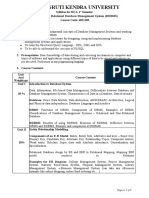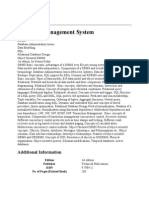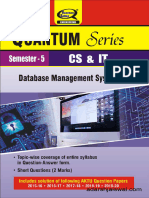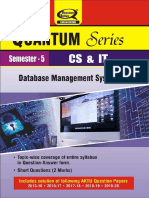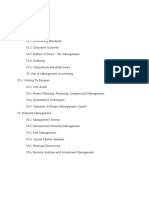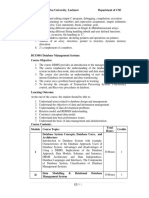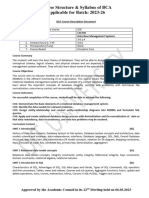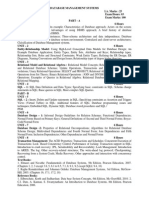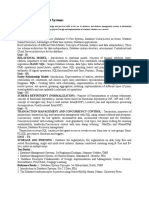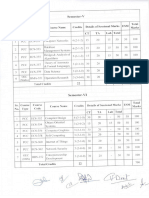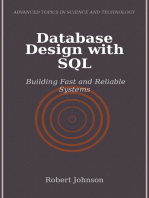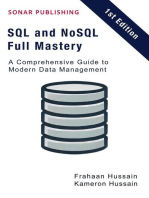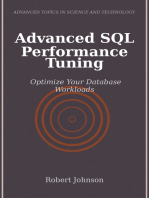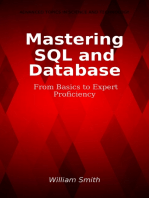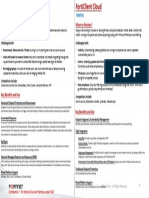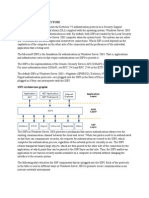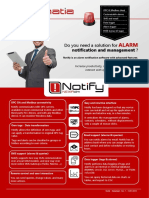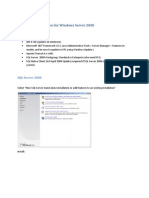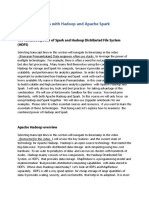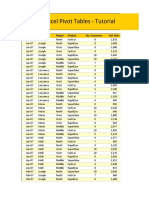Relational Database Management Systems (RDB) : at Internal Assessment, # External Assessment
Relational Database Management Systems (RDB) : at Internal Assessment, # External Assessment
Uploaded by
JaveedBurhanCopyright:
Available Formats
Relational Database Management Systems (RDB) : at Internal Assessment, # External Assessment
Relational Database Management Systems (RDB) : at Internal Assessment, # External Assessment
Uploaded by
JaveedBurhanOriginal Title
Copyright
Available Formats
Share this document
Did you find this document useful?
Is this content inappropriate?
Copyright:
Available Formats
Relational Database Management Systems (RDB) : at Internal Assessment, # External Assessment
Relational Database Management Systems (RDB) : at Internal Assessment, # External Assessment
Uploaded by
JaveedBurhanCopyright:
Available Formats
Relational Database Management Systems [RDB]
S.Y. Diploma : Sem. III [CO/CM/IF/CD] EVALUATION SYSTEM Theory Exam Practical Exam Oral Exam Term Work Class Test (Two Test) Time 3 Hrs. Marks 100 25# 25@ 25 (each)
@ Internal Assessment, # External Assessment
SYLLABUS 1. Database System Concept & Data Modeling Basic concepts, Disadvantages of file processing system, Advantages of a DBMS over file processing system, Data Abstraction, Database languages, Instance and Schema, Data Independence : Logical and Physical data Independence. Database Users, Functions of Data Administrator Components of a DBMS and overall structure of a DBMS : Query Processor and Storage Manager. Data Models : Network Model, Hierarchical Model, ER Model : Entity Sets, Mapping Cardinalities. Comparison of all models. Introduction to Client Server Architecture. 2. Relational Data Model, Security and Integrity Specification Relational Model : Basic concepts, attributes and domains. Key concept : Candidate and primary key. Integrity constraints : Domain, Entity Integrity constrints and On delete cascade. Security and Authorization. Query Languages : Relational Algebra, Relational Calculus : Domain and Tuple Calculus. Creating Views and all options and views. 3. SQL and PLSQL Introduction to SQL queries : Creating, Inserting, Updating and deleting tables (DDL), DML Statements using constraints. Renaming attributes, logical, relational, set operators. In and NOT In, IS NULL and IS NOT NULL, Aggregate functions, group by and having clause, string functions, date and time functions, Nested sub queries, Join concepts : Equi Join, Self Join, Non-Equi-Join, Outer Joins. PL/SQL Introduction, PL/SQL block structure, variables, SQL statements in PL/SQL, PL/SQL control structures, Cursors, Triggers, Functions. 4. Relational Database Design, Storage and File systems Purpose of Normalization, Data redundancy and updating anomalies, Functional Dependencies and Decomposition, Process of Normalization using 1NF, 2NF, 3NF, Multivalued dependencies and BCNF. ER Model details : Types of attributes, Role Indicator, Weak and Strong entity sets, Specialisation and Generalisation. File Organization, Organization of records in files, Basic concept of Indexing : Order Indices, Primary and Secondary Indices, Dense and Sparse Index, Sequential Indexing, Multilevel Indexing and Hashing. 5. Query Processing and Transaction Processing General strategies for query processing, Laws of Equivalence expressions, Concept of transaction, States of transactions, Serial Execution, Concurrent Executions, Serializability, Recoverability, Transaction Definition in SQL. Lock based protocols : share & exclusive mode, Protocols : 2 phase locking, TimeStamp based, Validation based. Deadlock handling, Wait for graph : Deadlock prevention Scheme, Deadlock Detection Scheme and recovery scheme.
Reference : 1. Database System Concepts (Korth) Sudarshan. 2. Introduction to Database Management Systems (2006 ISRD Group) Tata McGraw Hill. 3. An Introduction to Database System (Bipin Desai) Galgotia Publication. 4. An Introduction to Database System (C.J. Date). 5. Introduction to Relational Database and SQL programming (Allen) Tata McGraw Hill.
You might also like
- Fourth Semester: CS4B07: Fundamentals of Database Manage-Ment SystemsDocument2 pagesFourth Semester: CS4B07: Fundamentals of Database Manage-Ment Systemsharisummath5195No ratings yet
- Database Management SystemDocument2 pagesDatabase Management SystemK Nirmala AnantapurNo ratings yet
- DBMS Information SheetDocument3 pagesDBMS Information Sheetnaresh kumarNo ratings yet
- Code No.: ETCS 309 L T C Paper: Database Management Systems 3 1 4Document2 pagesCode No.: ETCS 309 L T C Paper: Database Management Systems 3 1 4Megha PokhriyalNo ratings yet
- Course FileDocument6 pagesCourse FilepthepronabNo ratings yet
- DBMS SyllabusDocument3 pagesDBMS SyllabusMANOJ KUMARNo ratings yet
- 3 - DDBMS SybDocument2 pages3 - DDBMS SybGayathri Bhupathi rajuNo ratings yet
- Sem 423Document9 pagesSem 423Sundari KaliNo ratings yet
- NEW REVSIED SYALLBUS Academic Year 2019-20 Fybsc (CS) Dbms-1 Chapter 1 Introduction of DBMS (No. of Lectures 4)Document5 pagesNEW REVSIED SYALLBUS Academic Year 2019-20 Fybsc (CS) Dbms-1 Chapter 1 Introduction of DBMS (No. of Lectures 4)ReenaRrbNo ratings yet
- Mca-1 Rdbms SyllabusDocument3 pagesMca-1 Rdbms Syllabussanket shahNo ratings yet
- SyllabusDocument5 pagesSyllabusDATLA LOKESH REDDYNo ratings yet
- Database Management SystemDocument4 pagesDatabase Management Systemreallynilay123No ratings yet
- III/IV B.Tech First Semester PVP14 Database Management Systems (Cs5T1) Department of Computer Science and Engineering Micro SyllabusDocument2 pagesIII/IV B.Tech First Semester PVP14 Database Management Systems (Cs5T1) Department of Computer Science and Engineering Micro SyllabusVenu ChintapalliNo ratings yet
- Course Plan DBMSDocument3 pagesCourse Plan DBMSrohitguptasocial2No ratings yet
- Database Management System: Additional InformationDocument2 pagesDatabase Management System: Additional InformationJason HarrisonNo ratings yet
- Database Management System (Book)Document284 pagesDatabase Management System (Book)Mradul Dixit100% (2)
- C++ Language: (No. of HRS: 09)Document6 pagesC++ Language: (No. of HRS: 09)Clyde JonesNo ratings yet
- Database Management SystemDocument284 pagesDatabase Management Systemavinash pandeyNo ratings yet
- V Sem Syllabus 2020-21200121020338270921011611Document13 pagesV Sem Syllabus 2020-21200121020338270921011611Anmol SharmaNo ratings yet
- Database Management SystemDocument80 pagesDatabase Management SystemrajeshNo ratings yet
- CP201 Database Management Systems:: CREDITS 6 (L 4, T 0, P 2)Document3 pagesCP201 Database Management Systems:: CREDITS 6 (L 4, T 0, P 2)viral patelNo ratings yet
- Database Management Quantum SebDocument284 pagesDatabase Management Quantum SebShivanshu Verma50% (4)
- Credits: 3Document1 pageCredits: 3Sayan Kumar KhanNo ratings yet
- PUCIT Database Systems Course OutlineDocument5 pagesPUCIT Database Systems Course OutlinemirzamwaqarNo ratings yet
- Semester-8: CSE-402 E Distributed Operating SystemDocument5 pagesSemester-8: CSE-402 E Distributed Operating Systemamit_mastboyNo ratings yet
- Bca Iii DBMS SyllabusDocument4 pagesBca Iii DBMS SyllabusrightisbeautyNo ratings yet
- Database Management Systems: Course Description and ObjectivesDocument3 pagesDatabase Management Systems: Course Description and Objectivesash 3No ratings yet
- B. Sc. (Information Technology) Semester - IIIDocument2 pagesB. Sc. (Information Technology) Semester - IIISony TiwariNo ratings yet
- TMC 204 Database Management SystemDocument3 pagesTMC 204 Database Management SystemSuraj BishtNo ratings yet
- Fundamentals Fo Database Course Outline 2023 For StdeuntsDocument4 pagesFundamentals Fo Database Course Outline 2023 For Stdeuntsbeshahashenafe20No ratings yet
- SE ZC323 Course HandoutDocument9 pagesSE ZC323 Course Handoutpdparthasarathy03No ratings yet
- Indicative Syllabus Discipline: FinanceDocument10 pagesIndicative Syllabus Discipline: Financehaardik03No ratings yet
- Bachelor of Technology Information Technology: Credits Earned: 5 Credits Course OutcomesDocument19 pagesBachelor of Technology Information Technology: Credits Earned: 5 Credits Course OutcomesHeartTouching UnpluggedNo ratings yet
- IT Sem 4Document17 pagesIT Sem 4Nikhil KhandelwalNo ratings yet
- Database Management SystemsDocument2 pagesDatabase Management SystemschatnarenNo ratings yet
- VTU Database Management Systems 2010 SYLLABUSDocument3 pagesVTU Database Management Systems 2010 SYLLABUSVishwas N PrasadNo ratings yet
- CSC2203 Database Systems: Course Information SheetDocument3 pagesCSC2203 Database Systems: Course Information SheetFaisal Rehman KhanNo ratings yet
- DBMS SyllabusDocument3 pagesDBMS Syllabusvaibhavsharma8529egNo ratings yet
- CS-2004 Database Management Systems Cr-4: Course Outcome: at The End of The Course, The Students Will Be Able ToDocument2 pagesCS-2004 Database Management Systems Cr-4: Course Outcome: at The End of The Course, The Students Will Be Able To089ASHUTOSH PATINo ratings yet
- DbmsDocument2 pagesDbmsyashkumar2035No ratings yet
- Bs14 Database Management SystemDocument2 pagesBs14 Database Management SystemNaresh GulatiNo ratings yet
- Database Management SystemDocument4 pagesDatabase Management SystemShruti PantNo ratings yet
- Dbms Vtu NotesDocument104 pagesDbms Vtu NotessatyaNo ratings yet
- Downloadfile PagesDocument1 pageDownloadfile Pagesyasivo4367No ratings yet
- DBMS (EE604A) Syllabus R18Document2 pagesDBMS (EE604A) Syllabus R18Sayani ChandraNo ratings yet
- Syllabus CAF106 (DBMS)Document2 pagesSyllabus CAF106 (DBMS)udit rawatNo ratings yet
- 1.syllabus 10cs54 DbmsDocument1 page1.syllabus 10cs54 DbmsnaguananthNo ratings yet
- Database Management System12Document1 pageDatabase Management System12chatnarenNo ratings yet
- ISh116 Course Outline-1Document5 pagesISh116 Course Outline-1Courtney Kudra DzereNo ratings yet
- Cse V Database Management Systems 10cs54 NotesDocument115 pagesCse V Database Management Systems 10cs54 NotesBEWIF COCOMOYNo ratings yet
- Module 1 DBMSDocument157 pagesModule 1 DBMSsreekanthpyatagoudaNo ratings yet
- Dbms Notes (2010) (Sjbit)Document116 pagesDbms Notes (2010) (Sjbit)Honey SoniNo ratings yet
- Lecture Plan DbmsDocument1 pageLecture Plan Dbmshimanshus13No ratings yet
- DBMS - 3rd Year VI Semester - AICTE 2020-21 - 9 March 2021Document2 pagesDBMS - 3rd Year VI Semester - AICTE 2020-21 - 9 March 2021RAtnaNo ratings yet
- DBMSDocument3 pagesDBMSDr. Sanjay AgalNo ratings yet
- 3rd CSE IT New Syllabus 2019 20Document19 pages3rd CSE IT New Syllabus 2019 20Harsh Vardhan HBTUNo ratings yet
- Database Design with SQL: Building Fast and Reliable SystemsFrom EverandDatabase Design with SQL: Building Fast and Reliable SystemsNo ratings yet
- SQL and NoSQL Full Mastery: A Comprehensive Guide to Modern Data ManagementFrom EverandSQL and NoSQL Full Mastery: A Comprehensive Guide to Modern Data ManagementNo ratings yet
- Advanced SQL Performance Tuning: Optimize Your Database WorkloadsFrom EverandAdvanced SQL Performance Tuning: Optimize Your Database WorkloadsNo ratings yet
- Mastering SQL and Database: From Basics to Expert ProficiencyFrom EverandMastering SQL and Database: From Basics to Expert ProficiencyNo ratings yet
- EDR vs. Client Cheat SheetDocument1 pageEDR vs. Client Cheat SheetIsmail YoussefNo ratings yet
- Programming For IoT PDFDocument8 pagesProgramming For IoT PDFsartgNo ratings yet
- eDocBuilder SOAP IntroductionDocument5 pageseDocBuilder SOAP IntroductionanduNo ratings yet
- Nextcloud Manual PDFDocument83 pagesNextcloud Manual PDFLuis OrtegaNo ratings yet
- ISTQB Agile Tester Extension Sample Exam Answers-ASTQB-VersionDocument6 pagesISTQB Agile Tester Extension Sample Exam Answers-ASTQB-VersionCristina AciubotariteiNo ratings yet
- MODULE 4 - Normalization - 1Document107 pagesMODULE 4 - Normalization - 1adithyasabari321No ratings yet
- Operator Overloading & Dunder Methods - Python Tutorials For Absolute Beginners in Hindi #67Document3 pagesOperator Overloading & Dunder Methods - Python Tutorials For Absolute Beginners in Hindi #67Anonymous AZNo ratings yet
- My ResumeDocument3 pagesMy ResumeRavi VyasNo ratings yet
- Cisco Sdwan Design GuideDocument101 pagesCisco Sdwan Design GuideporurrajeshudtNo ratings yet
- Using Pre - and Post-Session SQL CommandsDocument5 pagesUsing Pre - and Post-Session SQL CommandsyprajuNo ratings yet
- Kerberos SSP ArchitectureDocument86 pagesKerberos SSP ArchitectureishuminiNo ratings yet
- DWDM Notes - Unit 1Document26 pagesDWDM Notes - Unit 1Kishor PeddiNo ratings yet
- Modulo 1 - Chapter 1 - QuestionsDocument21 pagesModulo 1 - Chapter 1 - QuestionsMoises MojicaNo ratings yet
- Notify Datasheet ENDocument2 pagesNotify Datasheet ENMamoon RiazNo ratings yet
- Aftermarket Custom Andriod OsDocument6 pagesAftermarket Custom Andriod OsKunal maneNo ratings yet
- Sharepoint Job ProfileDocument2 pagesSharepoint Job ProfilePrasad KshirsagarNo ratings yet
- Datamining and Data Warehouse: By, M.E.Paar RivananDocument13 pagesDatamining and Data Warehouse: By, M.E.Paar Rivanannarayana143No ratings yet
- V6R2012 PLM Express Installation - SQL 2008Document45 pagesV6R2012 PLM Express Installation - SQL 2008Alin CristianNo ratings yet
- Sima Pro Installation Manual 820Document22 pagesSima Pro Installation Manual 820jasolanoroNo ratings yet
- Big Data Analytics With Hadoop and Apache SparkDocument17 pagesBig Data Analytics With Hadoop and Apache SparkFernando Andrés Hinojosa VillarrealNo ratings yet
- 3.0 ScienceLogic Capabilities and Solution Overview - v8Document30 pages3.0 ScienceLogic Capabilities and Solution Overview - v8Anthony MaidaNo ratings yet
- DocumentDocument3 pagesDocumentSakthivel GopalNo ratings yet
- Excel Pivot Tables TutorialDocument51 pagesExcel Pivot Tables TutorialprocriesNo ratings yet
- Database Management Systems Lab: Course Objectives: Course OutcomesDocument37 pagesDatabase Management Systems Lab: Course Objectives: Course OutcomessadweepNo ratings yet
- JavaScript Book Without Projects Code v1Document84 pagesJavaScript Book Without Projects Code v1yeechienNo ratings yet
- Unit - 2 Data Encapsulation & Inheritance: Rofel Bba & Bca College, VapiDocument33 pagesUnit - 2 Data Encapsulation & Inheritance: Rofel Bba & Bca College, Vapiاریب صديقيNo ratings yet
- System Admin SampleDocument2 pagesSystem Admin SampleZiad JaberNo ratings yet
- Questions On OLAP ServicesDocument11 pagesQuestions On OLAP ServicesppavandsNo ratings yet
- SAP Advanced Planning and Optimization, Demand Planning Add-In For Microsoft ExcelDocument4 pagesSAP Advanced Planning and Optimization, Demand Planning Add-In For Microsoft ExcelnileshNo ratings yet
- MashupDocument60 pagesMashuparnitha_akhilaNo ratings yet









